No products in the cart.
Blog
How To Remove Tea Stains From Cups To Obtain Stain-Free Sipping
Tea stains on cups can be an unsightly nuisance, tarnishing the enjoyment of your favorite brew. From the delicate aromas of green tea to the rich flavors of black tea, these stains can stubbornly cling to your mugs, affecting their appearance and potentially altering the taste of future beverages. However, fear not! With a few simple techniques and household ingredients, you can easily banish tea stains from your cups, restoring them to their pristine condition and ensuring stain-free sipping every time.
What Causes Tea Stains On Mugs?
Understanding the root cause of tea stains is the first step in effectively removing them. Tea stains are primarily caused by tannins, natural compounds found in tea leaves. When tea is brewed and left to sit in a cup for extended periods, these tannins can adhere to the surface of the mug, creating unsightly brown stains. Additionally, factors such as the temperature of the water used to brew the tea and the type of tea leaves can influence the severity of staining.

What Causes My Dishwasher Not To Clean Tea Stains?
While dishwashers are convenient appliances for cleaning dishes, they may not always effectively remove tea stains from cups. Several factors can contribute to this:
- Water Temperature: The water temperature in your dishwasher plays a crucial role in dissolving and removing stains. If the water is not hot enough, it may not effectively break down the tannins responsible for the stains.
- Detergent Quality: Using a low-quality or insufficient amount of dishwasher detergent can hinder the cleaning process, leaving behind stubborn tea stains.
- Dishwasher Maintenance: A dirty or poorly maintained dishwasher may not function optimally, resulting in inadequate cleaning of tea stains. Regular cleaning and maintenance of your dishwasher can help improve its performance.
How to Remove Tea Stains From Cups
Removing tea stains from cups doesn’t have to be a daunting task. With the right approach and a few household ingredients, you can effectively eliminate those stubborn stains and restore your cups to their former glory. Here’s a detailed guide:
Clean The Stain On The Cup Or Mug With Soap
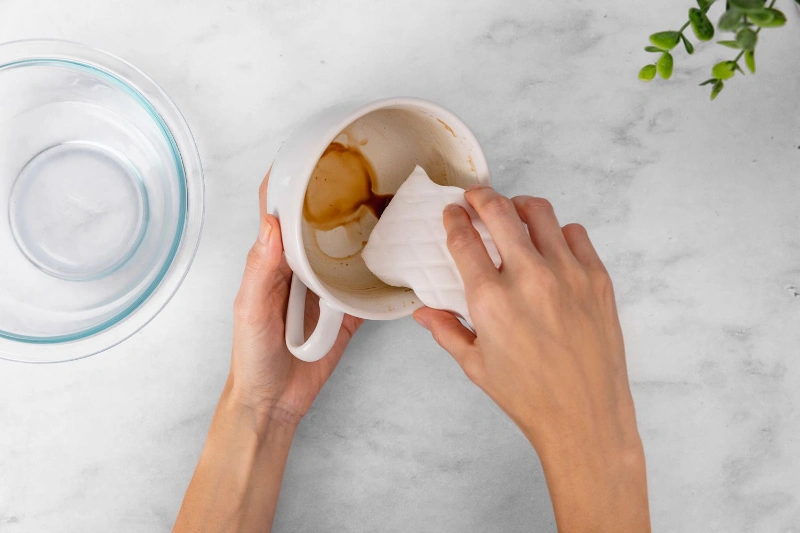
Start by rinsing the stained cup with warm water to loosen any surface residue. Then, apply a small amount of mild dish soap to a sponge or soft cloth and gently scrub the stained area. Pay particular attention to any crevices or grooves where tea residue may be trapped. Rinse the cup thoroughly with water to remove any soap residue.
Move on to Baking Soda
Baking soda, with its mild abrasive properties, is an excellent natural cleaner for removing tea stains. Create a paste by mixing baking soda with a small amount of water until it forms a thick consistency. Apply the paste to the stained areas of the cup and let it sit for 10-15 minutes to allow the baking soda to penetrate the stains. Then, use a sponge or soft brush to gently scrub the stains in circular motions. Rinse the cup thoroughly with water to remove the baking soda residue.
Vinegar Will Get the Job Done
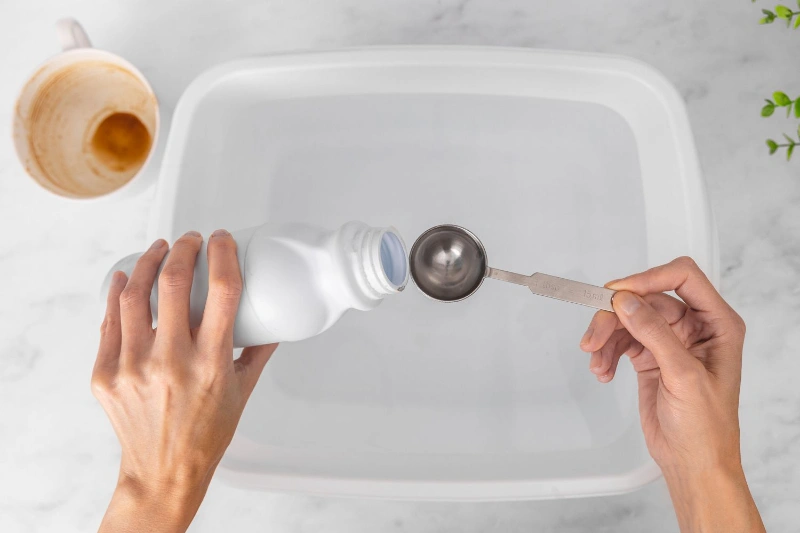
Vinegar is another powerful ally in the battle against tea stains, thanks to its acidic properties. Fill the stained cup with equal parts vinegar and water, ensuring that the stains are fully submerged. Let the cup soak for at least 30 minutes, or overnight for stubborn stains. The acidic nature of vinegar helps to dissolve and loosen the tea stains, making them easier to remove. After soaking, empty the cup and rinse it thoroughly with water. If any stains remain, repeat the soaking process until the cup is completely clean.
How to Avoid Tea Stains
Those are some interesting tips! Let’s break them down:
Choose Green Tea Over Black Tea
Black tea contains higher levels of tannins compared to green tea. Tannins are natural compounds found in tea leaves that contribute to their flavor and astringency. However, they are also responsible for the dark color of black tea and can easily adhere to surfaces, causing stains.
Green tea, on the other hand, undergoes minimal oxidation during processing, resulting in lower tannin levels and a lighter color. Opting for green tea can thus reduce the likelihood of stubborn stains forming in your teaware.
Let a Mug Soak Before Washing
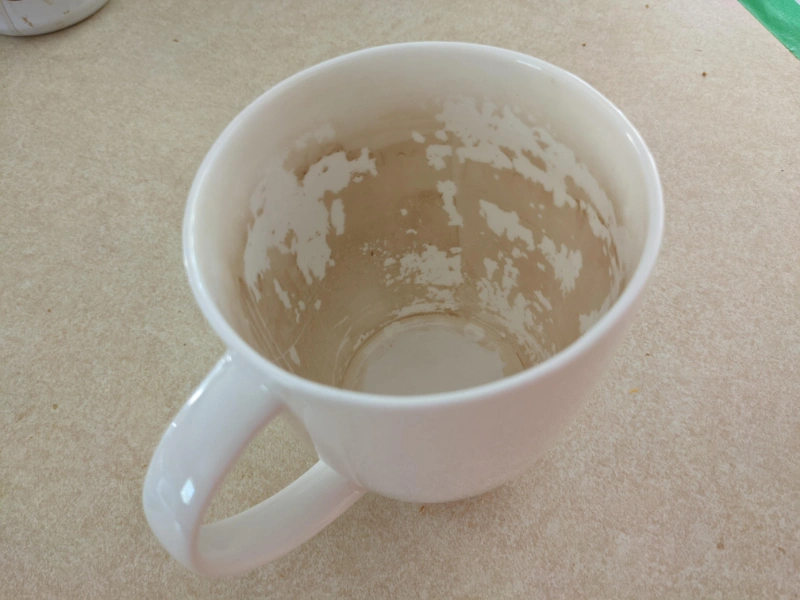
Sometimes, tea stains can be challenging to remove, especially if they’ve had time to dry and set into the surface of your mug or teapot. Allowing your teaware to soak in warm water for a period before washing can help to loosen these stains, making them easier to clean off later. You can even add a small amount of dish soap or baking soda to the water for added stain-fighting power.
Use Non-Abrasive, Chemical-Free Cleaners
While it might be tempting to reach for abrasive cleaners or harsh chemicals to tackle tough tea stains, these products can be damaging to delicate teaware, especially if it’s made of materials like ceramic or porcelain. Instead, opt for non-abrasive, chemical-free cleaners that are gentle on surfaces but still effective at removing stains. Natural cleaners like white vinegar or lemon juice diluted in water can work wonders without posing any risk to your teaware.
Choose a Darker Shade of Teaware
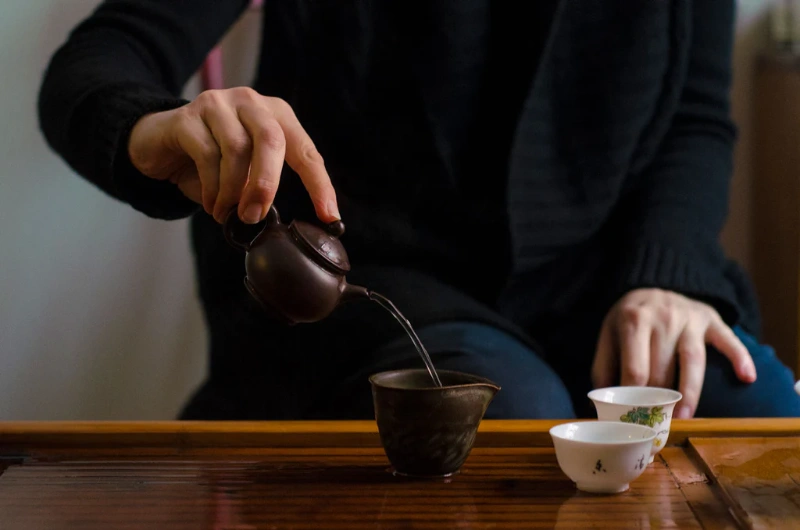
If you’re particularly concerned about tea stains being visible on your teaware, consider opting for teacups, mugs, or teapots in darker shades or patterns. Darker colors, such as deep blues, greens, or browns, can help to camouflage any stains that do occur, making them less noticeable between cleanings. Additionally, intricate patterns or textured surfaces can also help to disguise stains and imperfections.
Add Milk to Your Tea
Adding milk to your tea not only changes its flavor and texture but can also help to reduce the likelihood of staining. The proteins and fats in milk can bind to the tannins present in tea, forming complexes that are less likely to adhere to surfaces. This can help to prevent tea stains from forming on the inside of your mug or teapot. However, it’s worth noting that adding milk may not be suitable for all types of tea or personal preferences, so this tip may not be applicable in every situation.

FAQs
Can I use bleach to remove tea stains from cups?
While bleach can be effective at removing stains, it’s not recommended for use on cups or mugs that you plan to drink from. Bleach is a harsh chemical that can leave behind harmful residues and affect the taste of your beverages.
Are there any commercial products specifically designed to remove tea stains?
Yes, there are several commercial products available that are formulated to remove tea stains from cups and mugs. These products typically contain ingredients such as citric acid or oxalic acid, which help to dissolve and lift away stains. Follow the instructions on the product label for best results.
How can I prevent tea stains from forming in the first place?
To prevent tea stains, try to rinse your cups or mugs immediately after use to remove any residual tea. If stains do develop, regularly clean your cups with mild dish soap and warm water, or use one of the methods mentioned above to remove stubborn stains.
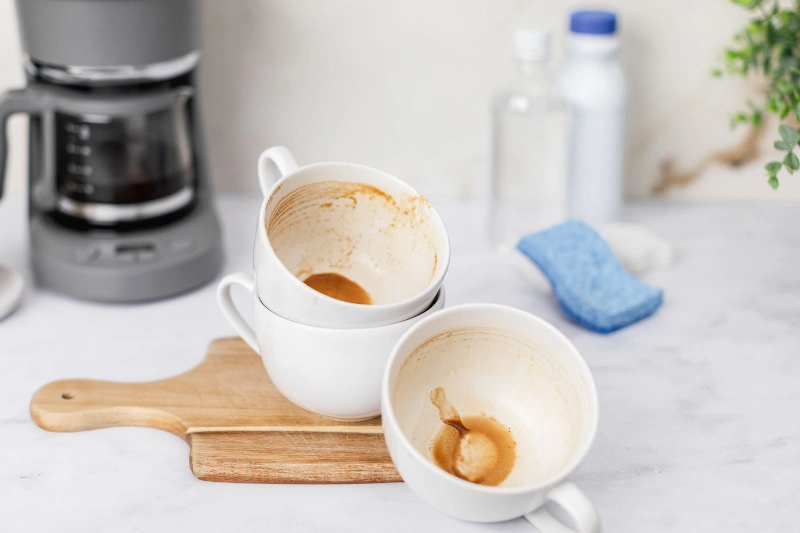
Conclusion
Tea stains on cups may seem like an inevitable inconvenience, but with the right techniques and ingredients, you can easily remove them and enjoy stain-free sipping every time. Whether you opt for gentle soap and water, the abrasive power of baking soda, or the acidic properties of vinegar, there’s a solution to suit every preference and cup. So, say goodbye to unsightly stains and hello to pristine tea-drinking experiences! With a little effort and know-how, you can keep your cups looking clean and ready for your next cup of tea.


